Career Firefighter Dies from Injuries Received during a Chimney and Structural Collapse after a House Fire - Pennsylvania
 Death in the Line of Duty…A summary of a NIOSH fire fighter fatality investigation
Death in the Line of Duty…A summary of a NIOSH fire fighter fatality investigation
F2003-04 Date Released: June 1, 2004
SUMMARY
On January 20, 2003, a 22-year old male career fire fighter (the victim) was fatally injured after being trapped during a structural collapse following a house fire. The victim was performing overhaul on the first floor when a chimney fell causing a structural collapse. The victim and two other fire fighters became trapped under the debris of the chimney and second floor. The victim was removed from the collapse within 10 minutes. He was transported via helicopter to a regional hospital where he was pronounced dead.
NIOSH investigators concluded that, to minimize the risk of similar occurrences, fire departments should:
- ensure that an assessment of the stability and safety of the structure (e.g., roofs, ceilings, partitions, load-bearing walls, floors, and chimneys) is conducted before entering fire and water-damaged structures for overhaul operations
- establish and monitor a collapse zone to ensure that no activities take place within this area as part of overhaul operations
- ensure that an Incident Safety Officer, independent from the Incident Commander, is appointed and on scene early in the fire operation
- ensure consistent use of personal alert safety system (PASS) devices even during overhaul operations
- ensure that fire fighters who enter hazardous areas, e.g., suspected unsafe structures during overhaul, be equipped with two-way communications with Incident Command
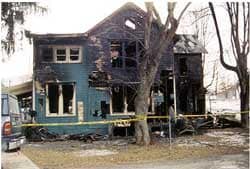
Incident site
INTRODUCTION
On January 20, 2003, a 22-year old male career fire fighter (the victim) was fatally injured during a structural collapse after a residential fire. On January 22, 2003, the U.S. Fire Administration (USFA) notified the National Institute for Occupational Safety and Health (NIOSH) of this fatality. On February 12-13, 2003, three occupational safety and health specialists from the NIOSH Fire Fighter Fatality Investigation and Prevention Program investigated the incident. The NIOSH team met with the Chief of the department involved in the incident and interviewed fire fighters who were on the scene. The incident site was visited by the NIOSH team for orientation purposes only (the building and its contents had been removed prior to the NIOSH investigation). The department’s standard operating procedures (SOPs), training records of the victim, 911 dispatch transcripts and the medical examiner’s report were reviewed.
Fire Department
The fire department involved in this incident has 30 volunteer fire fighters that operate from a single station. The victim had been with the department for 4 years and was the only paid fire fighter within the combination department. The local township funded the salary of the victim. The department serves a rural area with a population of approximately 4,000 in an area of about 68 square miles. The victim also served as a Lieutenant in a neighboring volunteer fire department and had been a member of this department for 8 years.
Training
The victim had completed National Fire Protection Association (NFPA) Fire Fighter Level I and II training. Additional training included hazardous materials awareness (HazMat), pumper operations, search and rescue, rapid intervention team (RIT) operations, emergency vehicle operations, and wildland fire fighting.
Equipment and Personnel
There were 7 departments on scene prior to the collapse. The initial dispatch was at 1501 hours. Units and apparatus arrived as follows:
- Engine 12-2 (victim’s apparatus) at 1514 hours
- Engine 12-1 at 1518 hours with Assistant Chief (Incident Commander)
- Ambulance 12-9 at 1518 hours
- Tanker TNK12 at 1520 hours
- Brush Truck BR-12 at 1524 hours with Chief and Deputy Chief
- Ambulance 12-8 at 1531 hours
Mutual aid departments responded with 4 engines and 3 tankers. Approximately 50 fire fighters were on scene when the structural collapse occurred at 1705 hours.
Structure
The incident structure was a balloon-frame constructed, two-story, single-family residence built in the 1890s (Photos 1&2). Each floor had approximately 980 square feet of furnished living area, with a 980 square foot unfinished basement. The first floor had a living room, dining room and kitchen. There was a 60 square foot covered back porch at the rear of the structure. The second floor had several bedrooms. Exterior construction was wood clapboards over rough timber framing. The roof consisted of tin sheeting and the house set on a 70×100 foot level lot. Interior construction was plaster over wood lathe. Over the years, remodeling had concealed an interior brick chimney that was no longer in use. The chimney had been removed below the roof line and was not visible from the exterior.
According to the insurance adjuster, the origin and cause of the fire was faulty electrical wiring in a receptacle behind the couch in the living room on the first floor. The occupants of the home evacuated prior to arrival of fire fighters.
Weather
At the time of the fire, the weather was overcast with a temperature of approximately 45°F. At the time of the collapse, dusk was approaching with falling temperatures and negligible wind.
INVESTIGATION
On January 20, 2003, at 1501 hours, the victim and two other fire fighters were dispatched to an apartment fire in Engine 12-2 (Note: the initial dispatch incorrectly stated an apartment fire). The victim was driving. Another fire fighter who was familiar with the area could only recall a nursing home that could be considered an apartment. The victim radioed for additional resources (two additional tankers and two ambulances) en route based on this fact. The fire fighters could see smoke in the distance and on arrival at 1514 hours, found a two-story single family residence heavily involved. Thick black smoke and flames were blowing from the second floor windows and from under the roof eves. Some of the windows had already self-vented. The victim was the Incident Commander (IC) for a short time until the Assistant Chief arrived on the scene in Engine 12-1 at 1518 hours and assumed command.
Engine 12-2 was positioned on the east side of the structure. Engine 12-1 was the second apparatus on the scene at 1518 hours and Tanker 12 arrived at 1520 hours and began water supply to Engines 12-1 and 12-2.
The victim and a Deputy Chief made an interior attack through the rear of the structure using a 1-1/2 inch hand line. Heavy smoke and flames persisted, prompting the IC to switch from an offensive to a defensive attack. At 1550 hours, the IC called for an evacuation and surround and drown. Numerous hand lines were used from all exposure sides. During this time a partial interior floor collapse had occurred in the dining room. (Note: the collapse was heard and seen through the dining room windows). After approximately 20-25 minutes, the fire was knocked down and the overhaul operations were initiated.
The Deputy Chief and another fire fighter climbed a ladder from the ground to the roof of the back porch. (Note: The second floor stairs were completely burned out but the floor was still intact). At the same time, the victim and two other fire fighters entered the structure through the back door and began overhaul operations in the living room. They were looking for hot spots within the walls. The victim was the only firefighter wearing a self-contained breathing apparatus (SCBA) but the facepiece was not donned and none of the fire fighters had an activated PASS alarm. (Note: The firefighters had manual or secondary PASS devices that were either on their belts or in their pockets).
At 1700 hours, the Deputy Chief and the fire fighter that entered through the second story window used their ax handle to sound the floor before entering and cautiously climbed into the back bedroom and entered the central portion of the structure to begin overhauling attic hot spots. Prior to entering the hallway they encountered a 2 foot diameter hole burned through the floor. The Deputy Chief warned the fire fighter of the hole and they both jumped over it and proceeded into the hallway. As they entered, they noticed a brick chimney against the wall adjacent to the burned hole in the floor. The Deputy Chief, while using a pike pole on the ceiling, noticed the chimney beginning to lean forward. He placed both his hands against the chimney while straddling the burned hole in the floor and verbally ordered the other firefighter out of the structure because a collapse was imminent. The other firefighter quickly exited the structure through the back window. The Deputy Chief was unable to use his hand held radio in his bunker jacket pocket. The Deputy Chief held the chimney back for a few seconds and quickly exited as the chimney collapsed behind him onto and through the second floor.
At the same time that the Deputy Chief and fire fighter were on the second floor, the victim and two fire fighters were working underneath on the ground floor. They did not hear the Deputy Chief’s warnings about the impending collapse. The fire fighters were located against the southern exterior living room wall when the ceiling and chimney collapsed on them at 1705 hours (Diagram and Photo 3). The victim was trapped under the second floor structural members, floor boards, and the chimney debris. The other fire fighters were trapped in a pocket against the wall.
Within seconds after the collapse, a rapid intervention team (RIT) entered the structure and immediately began search and rescue for the three trapped fire fighters. Within a minute, one of the trapped fire fighters was yelling out to the RIT team while freeing himself from the collapse. Another fire fighter was rescued after his leg and foot became disentangled from the debris. He was carried from the structure, loaded into an ambulance and transported to the hospital. The victim was the last to be rescued about 10 minutes after the initial collapse. The RIT team used power saws to cut through the wooden debris and started a bucket brigade to remove the debris trapping the victim.
The IC remained outside while other officers went inside the structure assisting with the rescue. The scene became somewhat chaotic with all firefighters wanting to help with search and rescue. The IC ordered several fire fighters to shore the exterior walls to prevent a secondary collapse. Rescue and shoring occurred simultaneously.
Paramedics administered life support to the victim prior to his extrication, and once free, he was transported to an awaiting life flight helicopter and flown to the hospital. The victim was pronounced dead in the hospital at 2030 hours.
CAUSE OF DEATH
The medical examiner’s report listed the victim’s cause of death as compressional asphyxia as a result of being trapped from falling debris.
RECOMMENDATIONS/DISCUSSIONS
Recommendation #1: The Incident Commander should ensure that an assessment of the stability and safety of the structure (e.g., roofs, ceilings, partitions, load-bearing walls, floors, and chimney) is conducted before entering fire and water-damaged structures for overhaul operations.1
Discussion: Due to the destructive powers of fire, most structures that have been involved in fires are structurally weakened. Analysis of the exterior of the structure should be performed continuously while conducting interior operations. Similarly, before overhaul operations are begun, the structure should be determined safe to work in by the IC and a designated Safety Officer. If necessary, the IC should seek the help of qualified structural experts to assess the need for the removal of dangerously weakened construction, or should make provisions for shoring up load-bearing walls, floors, ceilings, roofs, or as in this case, a brick chimney. In this incident, had a thorough assessment been made of the structure, including the chimney, overhaul could have been delayed until the area around the chimney had been demolished or stabilized.
Recommendation #2: The Incident Commander should establish and monitor a collapse zone to ensure that no activities take place within this area as part of overhaul operations.1-4
Discussion: During fire operations, two rules exist about structural collapse: (1) the potential for structural failure always exists during and after a fire, and (2) a collapse danger zone must be established. The fire building was unstable and began to collapse during the fire suppression operations (Note: there was a prior collapse within the dining room), the interior stairwell had been destroyed, and the second floor had been burned through in one location. A defensive attack was declared soon after fire suppression activities began. Part of a defensive strategy is establishing and moving fire fighters outside of the collapse zone. A collapse zone is an area around and away from a structure in which debris might land if a structure fails. In this incident, the collapse sequence would have been harder to predict based on the fact the chimney had been concealed and removed below the roof line. Immediate safety precautions must be taken if factors indicate the potential for a building collapse. All persons operating inside the structure must be evacuated immediately and a collapse zone should be established around the perimeter. The collapse zone area should be equal to the height of the building plus an additional allowance for debris scatter, and at a minimum should be equal to 1-½ times the height of the building. For example, if the wall were 20 feet high, the collapse zone boundary should be established at least 30 feet away from the wall. Once a collapse zone has been established, the area should be clearly marked and monitored, to make certain that no fire fighters enter the danger zone.
Recommendation #3: Fire departments should ensure that an Incident Safety Officer, independent from the Incident Commander, is appointed and on scene early in the fire operation.2,5-8
Discussion: According to NFPA 1561, Sec. 4.1.1, the IC is responsible for the overall coordination and direction of all activities at an incident. This includes overall responsibility for the safety and health of all personnel operating on the fire ground. Whereas the IC is in overall command at the scene, certain functions must be delegated to ensure that adequate scene management is accomplished. NFPA 1500, Sec. 6-1.3 states, “As incidents escalate in size and complexity, the incident commander shall divide the incident into tactical-level management units and assign an incident safety officer to assess the incident scene for hazards or potential hazards.” The incident safety officer (ISO) is defined as “an individual appointed to respond to or assigned at an incident scene by the incident commander to perform the duties and responsibilities specified in this standard. This individual can be the health and safety officer or it can be a separate function.” NFPA 1521, Sec. 2-1.4.1 states, “an incident safety officer shall be appointed when activities, size, or need occurs.” Each of these guidelines complements each other and indicates that the incident commander is in overall command at the scene, but oversight of all operations is difficult. On-scene fire fighter health and safety is best preserved by delegating the function of safety and health oversight to a safety officer. In this incident, a safety officer was not designated. A designated safety officer could have assisted with continual size-up and timely communications regarding safety on the fireground.
Recommendation #4: Fire departments should ensure consistent use of personal alert safety system (PASS) devices even during overhaul operations.9-10
Discussion: PASS devices are electronic devices worn by the fire fighter that emit a loud and distinctive sound (alarm) if the fire fighter is motionless for more than 30 seconds. There are several types of PASS devices available. One type is integrated into the SCBA and is activated when the SCBA air cylinder is turned on. Manual or secondary PASS devices are also used throughout the fire service. The latter devices require the fire fighter to actively turn on the device as needed. All fire fighters should be equipped with a PASS device and instructed to activate the device immediately upon entering any hazardous area. In this incident, the victim had a secondary PASS device on the belt of his SCBA that was not activated. The other trapped fire fighters also had manual PASS devices which had not been activated. A sounding PASS alarm would have assisted the RIT team in locating the exact location of the trapped fire fighters.
Recommendation #5: Fire departments should ensure that fire fighters who enter hazardous areas, e.g., suspected unsafe structures during overhaul, be equipped with two-way communications with Incident Command.6
Discussion: Although face-to-face is the best form of communication, radio communication should be used when face-to-face communication is not possible. Radios are essential for efficient fireground operations and keeping units in communication with one another. They provide a means to update progress and are necessary to request assistance. The firefighter on the second floor, who witnessed the Deputy Chief holding the chimney back, was not equipped with a two-way radio. If he had been equipped with a portable radio, the Incident Commander may have been able to evacuate the structure prior to the collapse that trapped the victim and the two other fire fighters.
REFERENCES
- Dunn V [1988]. Collapse of burning buildings, a guide to fireground safety. Saddle Brook, NJ: PennWell.
- Dodson D [1999]. Fire department incident safety officer. New York: Delmar Publishers.
- NIOSH [1999]. Preventing injuries and deaths of fire fighters due to structural collapse. Morgantown, WV: U.S. Department of Health and Human Services, Centers for Disease Control and Prevention, National Institute for Occupational Safety and Health, DHHS (NIOSH) Publication No. 99-146.
- Delmar Publishers [2000]. Fire fighter’s handbook: essentials of fire fighting and emergency response. New York: Delmar Thomson Learning.
- NFPA [2002]. NFPA 1500, standard on fire department occupational safety and health program. Quincy, MA: National Fire Protection Association.
- Brunacini A. [1985] Fire Command. Quincy, MA: National Fire Protection Association.
- NFPA [2002]. NFPA 1561: standard on fire department incident management system. Quincy, MA: National Fire Protection Association.
- NFPA [2002]. NFPA 1521: standard on fire department safety officer. Quincy, MA: National Fire Protection Association.
- Foley SN, ed. [1998]. Fire department occupational health and safety standards handbook. 1st ed. Quincy, MA: National Fire Protection Association.
- NFPA [1998]. NFPA 1982, standard on personal alert safety systems (PASS). Quincy, MA: National Fire Protection Association.
INVESTIGATOR INFORMATION
This investigation was conducted by Jay Tarley, Carolyn Guglielmo and Steve Berardinelli, Safety and Occupational Health Specialists, Surveillance and Field Investigations Branch, Division of Safety Research, NIOSH. The investigation was led by Jay Tarley and the report was prepared by Steve Berardinelli.
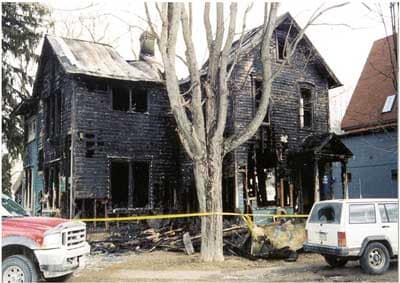
Photo 1. Front of incident structure
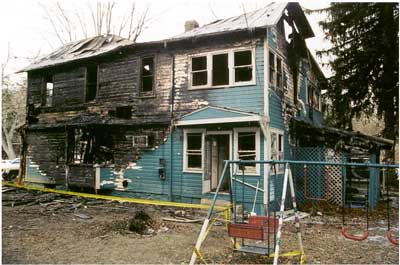
Photo 2. Rear of incident structure
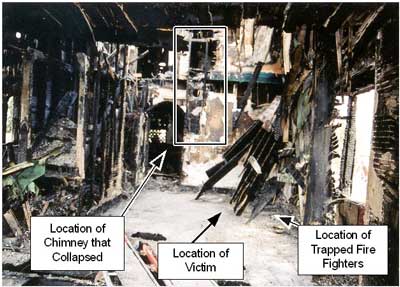
Photo 3. Site of structural collapse in living room after debris removal
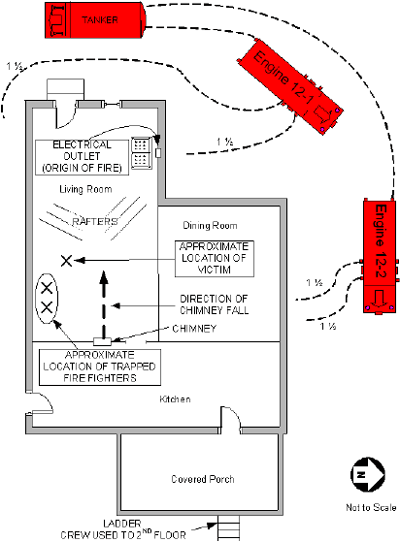
Diagram. Aerial view of incident scene showing area of collapse on 1st floor
This page was last updated on 06/02/04.
